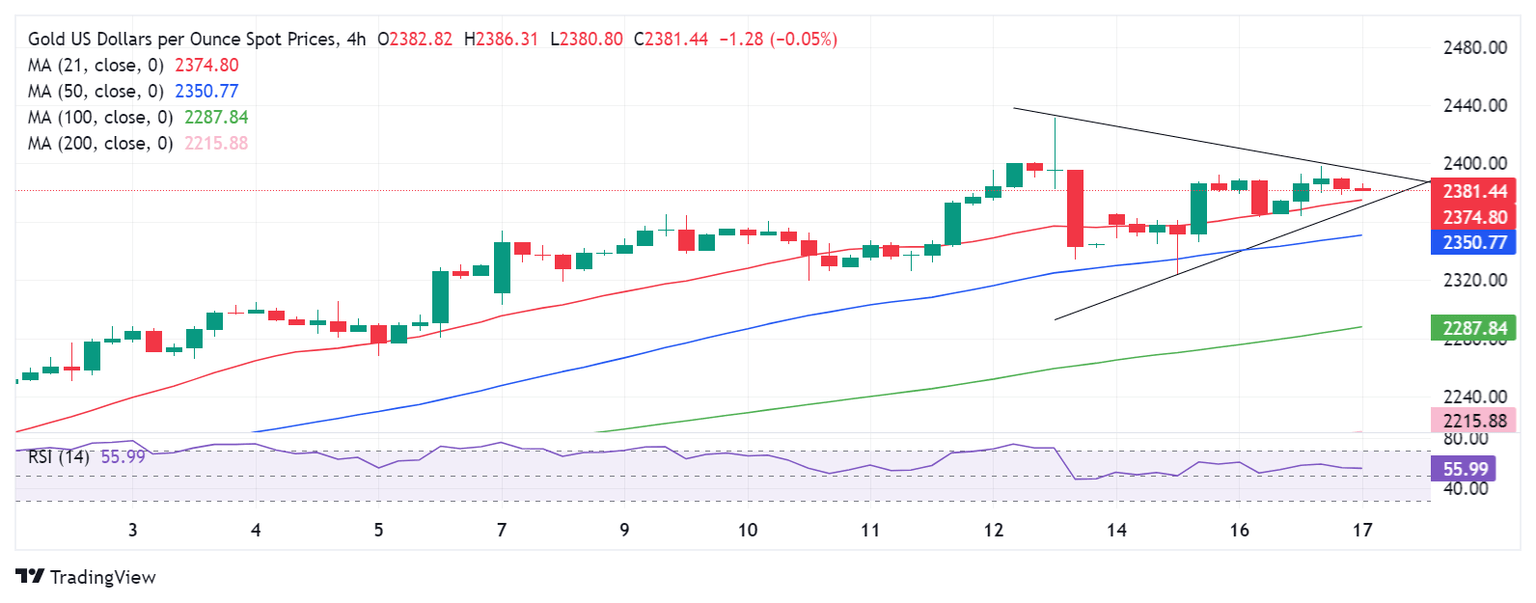Gold Price Forecast: XAU/USD pauses before the next push higher, Fedspeak awaited
- Gold price struggles below $2,400 as buyers refuse to give up.
- US Dollar eases with Treasury yields ahead of more Fedspeak.
- Gold price portrays a symmetrical triangle on the 4-hour chart, with a bullish RSI.

Gold price is battling it out just below $2,400 early Wednesday after witnessing a muted close a day ago. Gold price makes another attempt to recapture the $2,400 level, as the US Dollar (USD) follows a minor pullback in the US Treasury bond yields, awaiting a fresh bunch of US Federal Reserve (Fed) speakers.
Geopolitical woes outweigh hawkish Fed’s Powell?
Even though Iran has repeatedly said that it seeks no further escalation of its conflict with Israel, the Western response to the Iranian attack remains a cause of concern for investors, as they keep the safe-haven demand underpinned for Gold price.
White House National Security Adviser Jake Sullivan announced late Tuesday that the US will impose new sanctions against Iran’s missile and drone program, entities supporting Islamic Revolutionary Guard Corp. (IRGC) and the Defense Ministry.
Markets remain wary of the Iranian retaliation to the Western sanctions, which could translate into a wider regional conflict in the Middle East.
Gold prrice also capitalizes on a modest retreat in the US Dollar alongside the US Treasury bond yields, as traders catch a breather after the recent relentless upsurge while prepping up for another day swamped with a slew of Fed officials’ scheduled appearances.
A mild positive shift in risk sentiment also dents the safe-haven appeal of the US Dollar, as Gold price struggle for a fresh upside.
On Tuesday, the Gold price upswing was tempered by an unexpected hawkish turn in Fed Chair Jerome Powell’s comments, as he participated in a fireside chat about economic trends in North America at the Wilson Center’s Washington Forum in Washington, DC.
Powell said recent inflation data, with three months of upside surprises, had not given policymakers enough confidence to ease policy soon. He added that the central bank may need to keep rates higher for longer than previously thought. His comments further squashed expectations of Fed rate cuts this year, capping the upside in the non-interest-bearing Gold price.
Markets have already priced out bets for June and July Fed rate cuts, although chances of a September Fed rate reducton still stand at about 62%, according to the CME Group’s FedWatch Tool. This could also be seen as a reason Gold buyers stay hopeful of further gains, along with the underlying Middle East geopolitical risks.
Gold price technical analysis: Four-hour chart
As observed on the four-hour chart, Gold price has carved out a symmetrical triangle formation following its record-setting rally to $2,432.
Gold price remains at a critical juncture, although risks appear skewed to the upside, as the Relative Strength Index (RSI) holds well above the 50 level, currently near 56.0.
The bright metal needs a four-hour candlestick closing above the falling trendline resistance at $2,396 to confirm an upside break from the symmetrical triangle.
The next topside barrier will be seen at the record high of $2,432, above which the $2,450 psychological level aligns.
On the downside, acceptance below $2,375 is critical to validating a breakdown from the triangle, negating any bullish potential for Gold price. That level is the intersection of the triangle support line and the 21-Simple Moving Average (SMA).
The 50-SMA at $2,351 will be a tough nut to crack for Gold sellers if the weakness extends.
Further south, the previous week’s low of $2,319 could be the last line of defense for buyers.
Gold FAQs
Gold has played a key role in human’s history as it has been widely used as a store of value and medium of exchange. Currently, apart from its shine and usage for jewelry, the precious metal is widely seen as a safe-haven asset, meaning that it is considered a good investment during turbulent times. Gold is also widely seen as a hedge against inflation and against depreciating currencies as it doesn’t rely on any specific issuer or government.
Central banks are the biggest Gold holders. In their aim to support their currencies in turbulent times, central banks tend to diversify their reserves and buy Gold to improve the perceived strength of the economy and the currency. High Gold reserves can be a source of trust for a country’s solvency. Central banks added 1,136 tonnes of Gold worth around $70 billion to their reserves in 2022, according to data from the World Gold Council. This is the highest yearly purchase since records began. Central banks from emerging economies such as China, India and Turkey are quickly increasing their Gold reserves.
Gold has an inverse correlation with the US Dollar and US Treasuries, which are both major reserve and safe-haven assets. When the Dollar depreciates, Gold tends to rise, enabling investors and central banks to diversify their assets in turbulent times. Gold is also inversely correlated with risk assets. A rally in the stock market tends to weaken Gold price, while sell-offs in riskier markets tend to favor the precious metal.
The price can move due to a wide range of factors. Geopolitical instability or fears of a deep recession can quickly make Gold price escalate due to its safe-haven status. As a yield-less asset, Gold tends to rise with lower interest rates, while higher cost of money usually weighs down on the yellow metal. Still, most moves depend on how the US Dollar (USD) behaves as the asset is priced in dollars (XAU/USD). A strong Dollar tends to keep the price of Gold controlled, whereas a weaker Dollar is likely to push Gold prices up.
Premium
You have reached your limit of 3 free articles for this month.
Start your subscription and get access to all our original articles.
Author

Dhwani Mehta
FXStreet
Residing in Mumbai (India), Dhwani is a Senior Analyst and Manager of the Asian session at FXStreet. She has over 10 years of experience in analyzing and covering the global financial markets, with specialization in Forex and commodities markets.


















